
When the Holidays Hurt: Understanding the Holiday Blues and How to Cope
Not everyone feels joyful during the holiday season—and that doesn’t make you ungrateful or broken. The holidays can stir up grief, loneliness, pressure, and pain. You’re allowed to feel it, and you don’t have to navigate it alone.

Coping with Addiction During the Holidays: Triggers, Tools, and Support
The holidays can heighten addiction triggers, stress, and emotional struggles. Learn why this time of year is so challenging and how to navigate it with a recovery plan, self-awareness, and support.

When the Seasons Shift: Understanding and Managing Seasonal Affective Disorder
If winter leaves you feeling heavy, low, or unlike yourself, it may be more than just the blues. Seasonal Affective Disorder is a very real experience—one that deserves understanding, not judgment.

Autumn Anxiety: Why Fall Can Trigger Emotional Ups and Downs
Many people feel more anxious, restless, or low in the fall without knowing why. Learn what causes autumn anxiety, how seasonal changes affect your mental health, and how counselling can help you feel more grounded.

Feeling Back-to-School Jitters? Support and Counselling Tips for Families in Coquitlam
Back-to-school anxiety affects many youth, young adults, and parents in Coquitlam each year. If the stress and nervousness around school feel overwhelming, professional counselling can provide the tools and support needed to manage anxiety and build confidence for a successful school year.

The Hidden Costs of Social Media: How It Impacts Youth Mental Health
Social media is shaping how today’s youth see themselves and the world around them. Learn how it impacts teen mental health — from self-esteem and sleep to anxiety and cyberbullying — and what parents can do to support healthier digital habits.